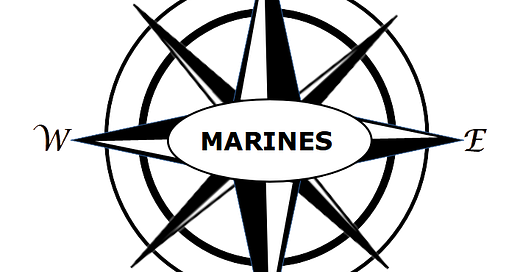Compass Points - Next Crisis Up
How to organize for crisis response.
August 3, 2024
.
The US is facing the next crisis up. How will the Marines help?
Reuters and other news outlets have reported that while Hamas chief Ismail Haniyeh was staying in Iran, he was killed in an explosion carried out by Israeli security forces. Iran has vowed to retaliate.
To help forestall wider conflicts in the Middle East, the US is rushing additional Naval units to the Middle East.
.
=============
.
West Coast carrier USS Abraham Lincoln (CVN-72) is setting sail to the Middle East from the Pacific to relieve the carrier USS Theodore Roosevelt (CVN-71) and its strike group. Meanwhile, the Navy is sending additional ships to the region following threats from Iran, Pentagon officials announced on Friday evening. “To maintain a carrier strike group presence in the Middle East, the Secretary has ordered the Lincoln Carrier Strike Group to replace the Theodore Roosevelt Carrier Strike Group, currently on deployment in the Central Command area of responsibility,” reads the Pentagon statement.
-- USNI News
.
=============
.
The Lincoln is in the Pacific in Hawaii but will now steam toward the Middle East. Also in the Pacific, the Marine Corps has its Marine Littoral Regiments and Stand-in-Forces that have been such a focus for the Marine Corps over the last 5 years. If these forces are so powerful, why not send them to the Middle East immediately?
The answer is the Marine Littoral Regiments and their Stand-in-Forces island missile units are mostly still only theoretical units, with theoretical capabilities. Even if they had substantial capabilities -- which they do not -- they are not organized for global crisis response. If missiles were needed, missile units could have been added to the MAGTF structure.
Although the current Commandant said recently that the Marine Corps' "Warfighting" publication is still foundational to all the Marine Corps does, the small missile units have never been organized the way Marine units should be, as a MAGTF.
.
=============
.
ORGANIZATION
The operating forces must be organized to provide forward deployed or rapidly deployable forces capable of conducting expeditionary operations in any environment. This means that in addition to maintaining their unique amphibious capability, the operating forces must maintain the capability to deploy by whatever means is appropriate to the situation.
The active operating forces must be capable of responding immediately to most types of crisis and conflict. Many sustained missions will require augmentation from the Reserve establishment. For operations and training, Marine forces will be formed into Marine air-ground task forces (MAGTFs). MAGTFs are task organizations consisting of ground, aviation, combat service support, and command elements. They have no standard structure, but rather are constituted as appropriate for the specific situation.
The MAGTF provides a single commander a combined arms force that can be tailored to the situation faced. As the situation changes, it may of course be necessary to restructure the MAGTF. Operating forces should be organized for warfighting and then adapted for peacetime rather than vice versa. Tables of organization should reflect the two central requirements of deployability and the ability to task-organize according to specific situations. Units should be organized according to type only to the extent dictated by training, administrative, and logistic requirements.
-- MCDP 1 - Warfighting
.
=============
.
When a crisis erupts, Marine forces must be able to respond immediately. The USS Lincoln is rushing from the Pacific to help in the Middle East. The Lincoln has flexible combat power that can be used around the globe. The small, isolated Marine missile units do not have flexible combat power that can be used around the globe. Despite all the funding, briefing, and attention the small Marine missile units have received over the last 5 years, they are still over-hyped and under performing.
While the Marine missile units will be of no use in the current Middle East crisis, the Marine Corps has a flexible and powerful combat force that will help, the Marine Air Ground Logistics Task Force. The three-ship Wasp Amphibious Ready Group with the embarked 24th Marine Expeditionary Unit is currently in the Eastern Mediterranean. The ARG, composed of USS Wasp (LHD-1), USS New York (LPD-21) and USS Oak Hill (LSD-51), and the 24th MEU are in position to conduct a non-combatant evacuation or a range of additional missions depending on how the crisis develops.
Compass Points salutes the 24th MEU and the Wasp Amphibious Ready Group as they face the next crisis up.
.
- - - - -
.
Reuters - 07/31/2024
Israelis buoyant after Hamas leader assassinated in Iran
By Ari Rabinovitch
.
- - - - -
.
USNI News - 08/02/2024
Carrier USS Abraham Lincoln Heads to Middle East as Iran Threatens Strikes Against Israel
By Sam LaGrone
.
- - - - -
.
Marines.mil







I have said repeatedly that the Marine Corps has become irrelevant globally. It has focused on a single mission in a single geographic location and after five years has yet to field a functional, war ready unit. In short, if war were tomorrow it could not contribute. This is a rendezvous with extinction as Congress will eventually figure out that a service of 160,000, with no ability to contribute to national defense has no further purpose. It will either need to rebuild it or disband it and distribute the remaining equipment, weaponry and personnel to the Navy, Air Force and Army.
So we are rather irrelevant in the current need to help prevent a widening war in the Middle East. I didn't think of that when asking what our capability would be to thwart China taking Taiwan or the Philippines. So given that the dramatic crippling of our Corps began five years ago and continues today, is it impolite to ask what will be done to determine accountability?